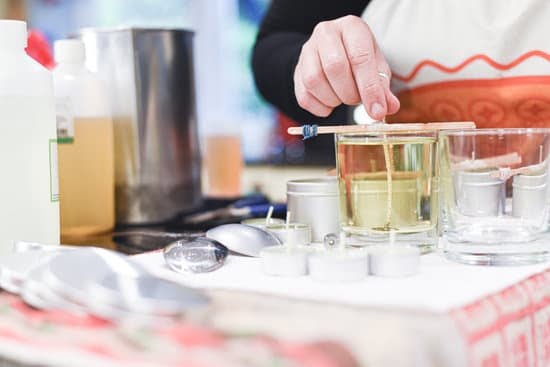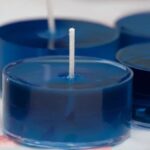Candle making has been a beloved craft for centuries, and it continues to enchant people today with its simplicity and versatility. In this article, we will explore the art of candle making, providing you with the knowledge to create your own beautiful homemade candles. From the history of candle making to troubleshooting common issues, we will guide you through each step of the process, empowering you to turn wax into works of art.
Homemade candles have seen a resurgence in popularity due to their personalized touch and appealing aesthetic. Whether for personal use, gifting, or even selling, there is something special about a handcrafted candle. The allure of creating unique scents and colors tailored to individual preferences has captivated many crafters and enthusiasts alike.
To begin our journey into the world of candle making, we will delve into the history and appeal of this timeless craft. From ancient civilizations to modern-day DIY trends, the lure of creating light and ambiance through handmade candles continues to endure. Join us as we uncover the magic behind this age-old practice and learn how to bring it into your own home.
Choosing the Right Wax
When it comes to making candles, one of the most important decisions you’ll make is choosing the right wax. There are several types of wax commonly used for candle making, including soy, paraffin, and beeswax, each with its own set of pros and cons.
Soy wax is a popular choice for many crafters due to its natural origins and clean burn, while paraffin wax is known for its excellent scent throw and ability to hold color well. Beeswax, on the other hand, offers a unique honey-like aroma and a longer burn time.
Factors to consider when selecting the right wax for your candles include cost, availability, fragrance retention, burning characteristics, and environmental impact. It’s important to weigh these factors against your specific candle making goals and preferences in order to choose the wax that best suits your needs.
In addition to considering the type of wax, you’ll also want to think about the form in which you purchase it. While some candle makers prefer working with pre-weighed flakes or pellets for easy measuring, others may opt for traditional blocks or even bulk liquid forms of wax. Ensuring that you have access to high-quality supplies from reliable sources will be essential in producing candles that meet your standards.
Finally, if you’re looking for budget-friendly options when it comes to purchasing wax for candle making, consider buying in bulk or sourcing materials from wholesale suppliers. This can help reduce costs while allowing you to create an abundance of beautiful homemade candles at a fraction of the price compared to retail options.
| Types of Wax | Characteristics |
|---|---|
| Soy Wax | Natural origin, clean burn |
| Paraffin Wax | Excellent scent throw and color retention |
| Beeswax | Unique honey-like aroma, longer burn time |
Essential Supplies and Equipment
When it comes to making your own candles, having the right supplies and equipment is essential for a successful and enjoyable candle-making experience. Some of the necessary supplies and tools include wax, wicks, fragrance oils, colorants, a double boiler or melting pot, a thermometer, molds or containers, and a scale for measuring ingredients.
These items can be found at craft stores, specialty candle-making shops, or online retailers. For those looking for budget-friendly options, consider purchasing supplies in bulk or looking for starter kits that provide everything you need to get started.
One of the most important elements of candle making is selecting the right wax for your project. The most common types of wax used in candle making are soy, paraffin, and beeswax. Each type has its own set of pros and cons to consider.
For example, soy wax is eco-friendly and produces a clean burn, while paraffin wax has excellent scent throw and comes in a variety of colors. Beeswax is known for its natural fragrance and long-lasting burn time. Consider factors such as cost, availability, burn quality, and environmental impact when deciding which type of wax to use.
In addition to wax selection and basic supplies such as wicks and fragrance oils, it’s important to have the right equipment on hand before starting your candle-making project. A double boiler or melting pot is essential for safely melting the wax without direct heat contact. A thermometer will help you monitor the temperature of the melted wax to ensure it reaches the proper pouring temperature.
Having molds or containers in various shapes and sizes allows for creativity in your candle designs. By equipping yourself with the necessary supplies and tools, you’ll be well-prepared to dive into the art of candle making with confidence.
Understanding Fragrances and Colors
When it comes to making candles, adding fragrance and color is an essential part of the process. The right combination of scents and colors can make your homemade candles not only visually appealing but also enticing to the senses. To start with fragrances, there are a wide variety of fragrance oils available specifically made for candle making.
These oils come in different scents such as floral, fruity, herbal, and seasonal options. It’s important to choose high-quality fragrance oils to ensure that the scent will last throughout the burning of the candle.
In addition to choosing the right fragrance, understanding how to properly color your candles is also crucial. There are several methods for coloring candles including using liquid dyes, dye blocks, or natural ingredients such as spices and herbs. Each method has its own unique process and effect on the candle’s appearance when lit. For those who prefer natural options, using ingredients like turmeric for yellow or beetroot powder for pink can create beautifully colored candles without artificial dyes.
Another consideration when it comes to coloring your candles is understanding how much dye or natural ingredient to add in order to achieve the desired shade. This requires some experimentation and testing before settling on a specific formula for each color you want to produce. It’s also worth noting that different waxes may require different amounts of colorants to achieve the same result.
Overall, mastering the art of selecting fragrances and colors for your homemade candles can be both creative and rewarding. By understanding these elements, you have the opportunity to customize your candle creations based on personal preferences or market demands.
| Fragrance & Color | Key Considerations |
|---|---|
| Fragrance Oils | Choose high-quality oils for long-lasting scent |
| Coloring Methods | Experiment with liquid dyes, dye blocks, or natural ingredients |
| Natural Options | Consider using spices and herbs for coloring without artificial dyes |
Step-by-Step Candle Making Process
Melting and Pouring Wax
The first step to making candles is melting the wax. This can be done using a double boiler or a dedicated wax melting pot. Once the wax is melted to the appropriate temperature, it is time to pour it into the chosen candle molds or containers. Be sure to position the wick in the center of the mold or container before pouring in the wax.
Adding Fragrance and Color
After pouring the melted wax into molds or containers, it’s time to add fragrance and color. When choosing fragrance oils, be sure to follow guidelines for proper usage rates to ensure a pleasant aroma without overwhelming the candle. Different methods can be used for coloring candles, including liquid dyes, color blocks, or natural options like herbs and spices.
Using Molds or Containers
Depending on personal preference and design choices, candles can be made in various shapes and sizes using different types of molds or containers. For molded candles, be sure to use quality molds that allow for easy release of the finished product. When using containers, consider options like glass jars or tins that are suitable for holding molten wax and withstand heat during burning.
Making candles is a rewarding and creative hobby that allows individuals to customize their own unique scents and colors. By following these step-by-step instructions on how to making candles, beginners can confidently embark on their candle making journey with ease. From choosing the right supplies and equipment to mastering the candle making process, creating homemade candles can become a fulfilling and enjoyable craft for anyone looking to explore this art form.
Troubleshooting Common Candle Making Issues
Dealing With Candle Tunneling and Surface Imperfections
Candle tunneling is a common issue that occurs when the wax burns down the center, leaving behind a thick wall of unmelted wax. To prevent this, it’s important to trim the wick to 1/4 inch before each use and allow the candle to burn long enough for the wax pool to reach the edges of the container.
Surface imperfections such as air bubbles or frosting can also occur during the cooling process. To minimize these issues, try pouring your wax at a slightly higher temperature and avoid rapid temperature changes during cooling.
Preventing Fragrance Fading in Finished Candles
One common problem that candle makers encounter is fragrance fading after the candles have been poured. To prevent this issue, it’s important to use high-quality fragrance oils that are specifically formulated for use in candles. Additionally, be sure to add the fragrance oil at the correct temperature and follow recommended usage rates. Properly curing your candles for at least 48 hours can also help to ensure that the scent is fully infused into the wax.
Tips for Minimizing Air Bubbles in the Wax
Air bubbles can sometimes form within the wax as it cools, creating an undesirable texture in finished candles. To minimize air bubbles, try gently tapping your filled containers on a flat surface immediately after pouring to release any trapped air.
Using a heat gun or torch to lightly warm the surface of the wax can also help to pop any remaining bubbles. Lastly, pouring your wax at a slightly warmer temperature and avoiding drafts during cooling can further reduce the likelihood of air bubbles forming.
Curing and Testing Your Candles
After the meticulous process of creating your homemade candles, it is crucial to allow them to cool and harden properly before testing for their burn qualities and scent throw. Curing your candles ensures that they are safe to use and have the best possible performance. Here is a step-by-step guide on how to cure and test your candles:
- Allow the candles to cool: After pouring the wax into the molds or containers, it is important to let the candles cool and harden at room temperature. This process can take several hours, depending on the size of the candle.
- Test for proper scent throw: Once the candles have cooled, you can check for their scent throw by lighting them in a well-ventilated area. Take note of how far the scent travels and whether it fills the room effectively.
- Examine burn quality: When testing your candles, observe how evenly they burn and if there is any smoke or soot produced. Make sure to trim the wicks before each use to prevent excessive smoking.
It’s important to handle newly made candles with care during this process while ensuring that they are placed on a heat-resistant surface when being burned. By properly curing and testing your candles, you can ensure that they are of high quality and ready for use or gifting.
Remember to always follow safety precautions when handling hot wax and lit candles, as well as when using fragrance oils. With these steps in mind, you can enjoy safe and beautifully scented homemade candles that will enhance any space in your home.
Packaging and Presentation
When it comes to packaging and presenting homemade candles, there are endless creative possibilities to make your products stand out. Whether you are making candles for personal use, as gifts, or for sale, the way you package and present them can make a significant impact. Here are some ideas and tips to help you elevate the presentation of your homemade candles:
- Consider using eco-friendly and sustainable packaging materials, such as recycled paper or cardboard.
- Personalize your candle labels and tags with unique designs, fonts, and even custom messages.
- Explore different container options for your candles, such as mason jars, vintage teacups, or sleek modern vessels.
Remember that the presentation of your candles can enhance the overall experience for the recipient. It can convey a sense of thoughtfulness and care, adding value to the product beyond just its functionality. Whether you are giving them as gifts or selling them, well-packaged and presented candles can leave a lasting impression on those who receive them.
In addition to packaging, consider how you will present your candles. If you are selling them at craft fairs or online marketplaces, think about how they will be displayed to attract potential buyers. Your presentation should reflect the style and feel of your brand while also showcasing the unique qualities of your handmade candles.
Ultimately, packaging and presentation play an essential role in creating a memorable and enjoyable experience for those who receive or purchase your homemade candles. With a thoughtful approach to packaging design and presentation methods, you can further enhance the appeal of your beautifully crafted candles.
Conclusion and Next Steps
In conclusion, candle making is a timeless and rewarding craft that allows individuals to express their creativity and create unique, personalized items for themselves or as gifts for others. With the right supplies, techniques, and creativity, anyone can learn how to make beautiful and fragrant candles at home. Whether it’s experimenting with different waxes and scents or mastering the art of presentation and packaging, there are endless opportunities for growth and exploration in this hobby.
For those who have been inspired by this article to try their hand at candle making, there are plenty of resources available for further learning and experimentation. Online tutorials, workshops, and forums offer valuable insights and tips from experienced candle makers.
Additionally, exploring local craft stores or specialty shops can provide access to a wide variety of supplies and materials needed for candle making. Finally, don’t be afraid to experiment with different techniques and ideas – the possibilities are endless when it comes to creating homemade candles.
While candle making may seem daunting at first, with practice and perseverance, anyone can develop the skills needed to create beautiful candles that fill a room with delightful aromas. So why not give it a try? Who knows – you might just discover a new passion. Happy candle making.
Frequently Asked Questions
How Do I Make My Own Candles at Home?
Making your own candles at home can be a fun and creative project. To start, you’ll need to gather the necessary materials like wax, wicks, a double boiler, fragrance oils, and containers for the candles.
Once you have everything you need, you can begin the candle making process by melting the wax, adding fragrance oils if desired, setting the wicks in the containers, and pouring the melted wax to create your homemade candles.
What Do I Need to Start Candle Making?
To start making your own candles at home, you’ll need several key supplies.
These include wax (such as soy wax or beeswax), candle wicks, a double boiler or melting pot to melt the wax, fragrance oils or essential oils for scent (if desired), a thermometer to monitor the temperature of the melted wax, and containers to pour the melted wax into.
How Do You Start Off Making Candles?
Starting off making candles involves preparing your workspace and gathering all of your materials. Once your materials are ready, you’ll begin by melting the wax using a double boiler or melting pot.
Then you’ll add any desired fragrance oils to the melted wax before carefully pouring it into containers with pre-set wicks. After allowing the candles to cool and set, you can trim the wick and enjoy your homemade creations!

Welcome to my candle making blog! In this blog, I will be sharing my tips and tricks for making candles. I will also be sharing some of my favorite recipes.





